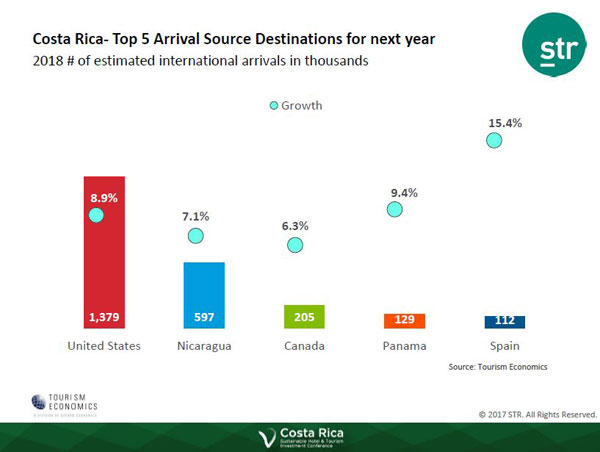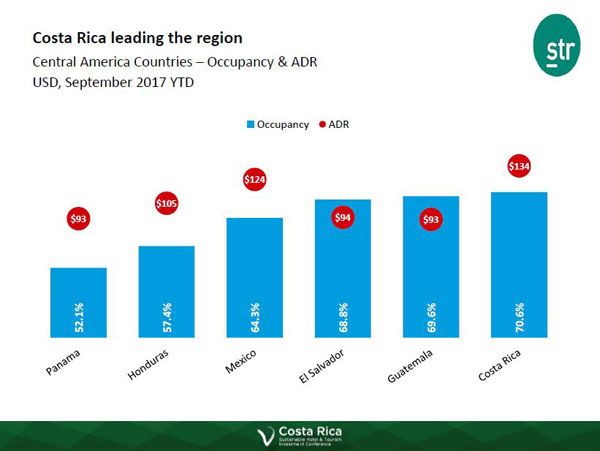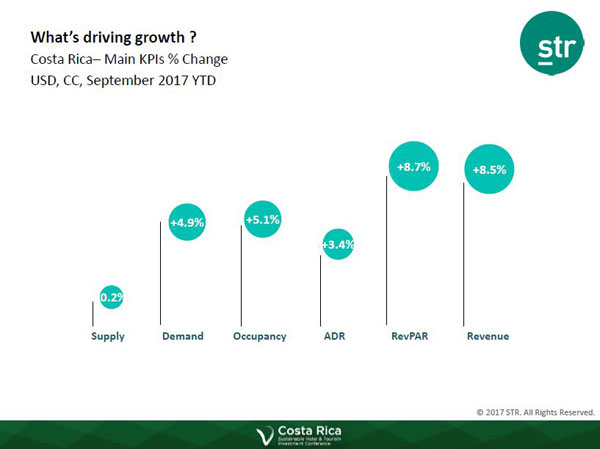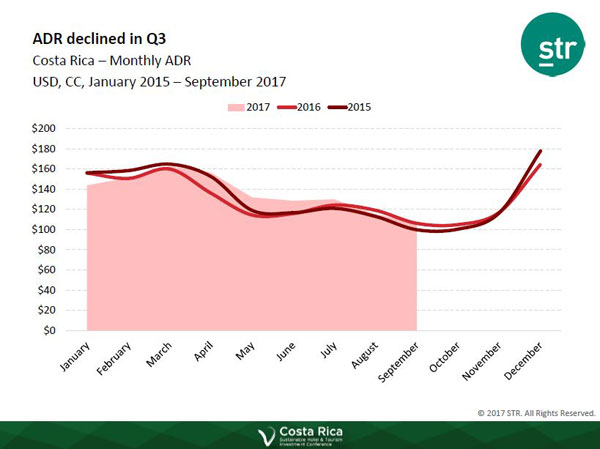✕

Column: industry Tag: Costa Rica,Marriott,Hotel Investment Published: 2017-11-21 13:48 Source: Author:

Paula Cerrillo, of Marriott International, talks about her company’s strategy for luxury development in Costa Rica during a panel discussion at SAHIC’s Costa Rica Sustainable Hotel & Tourism Investment Conference. Also on the panel was Ricardo Bravo, of AMResorts. (Photo: Robert McCune)
SAN JOSé, Costa Rica—A country of 19,714 square miles and 19,980 hotel rooms, Costa Rica has room to grow, but will do so at its own pace and by its own rules, said speakers at the Costa Rica Sustainable Hotel & Tourism Investment Conference.
The two-day event, organized by the South American Hotel Investment Conference and hosted by the Costa Rica Institute of Tourism (ICT) at the behest of the Costa Rican government, brought together tourism officials and investment and development experts.
The goal of the inaugural conference is to advance tourism—an industry which in 2016 was worth almost $4 billion in Costa Rica, and which employs about 600,000 (150,000 directly and 450,000 indirectly) of its nearly 5 billion people, according to Minister of Tourism Mauricio Ventura Aragón—by highlighting development opportunities.
But those opportunities only exist for the right sort of development, which in Costa Rica means sustainable and environmentally conscious.
That selectivity—which manifests in bureaucracy, tax rates and financial regulations—results in a slower pace of development, said Hermes Navarro del Valle, investment attractions coordinator at the ICT, on a panel titled “Investment and development opportunities in Costa Rica.” But in Costa Rica, “it’s the only way to go,” he said via translation.
That slower pace, he said, “helps us to think about what we want to do with our tourism model … (and also) to be at peace with the population and clientele … to protect our nature, environment—not only for tourism, but also for Costa Ricans, also for our future as a population. …
“If we opened too fast, maybe the results would not be what they are today,” he said. “People keep coming back to visit, which means they are finding what they are seeking.”
He added that capacity and growth for Costa Rica must be looked at very carefully.
“In some instances, you can get up at 7 a.m. and have the whole beach to yourself. That kind of experience is also what brings people back,” he said. “We have to maintain that quality.”
Growing demand
Tourism Economics predicts 1.38 million people (an 8.9% year-over-year increase) will arrive in Costa Rica in 2018 from the U.S., its top source country. Arrivals are also expected to grow from Nicaragua (+7.1% to 597,000), Canada (+6.3% to 205,000), Panama (+9.4% to 129,000) and Spain (+15.4% to 112,000).

“Costa Rica is a country that had a million visitors in 2000, 2 million in 2008 before the recession, and I think has around 3 million now,” Oriol Gimenez, partner at private-equity firm CPG Real Estate, said via translation during a general session titled “The financial agenda.”
That number could be even higher for 2018, he said.
“That’s an indicator of an industry that has been quite successful and knows how to position itself in style and zone,” he said, but added that “doesn’t necessarily translate to growth of hotel offerings.” For that, he said, it will be important for the Costa Rican government to offer incentives for investment—for example, tourism credits to help mitigate the high cost of development.
Gustavo Alvarado Chaves, tourism management director at the Costa Rican Tourism Board, said via translation that international arrivals through all ports have grown about 800% in the past 32 years.
The main drivers behind that growth, he said, are “sun and beaches, eco-tourism, adventure, wellness, sports and culture.”
On average, tourists to Costa Rica stay 12 nights, though not all in the same location, said the Ministry of Tourism’s Aragón, who added that only New Zealand has longer stays, according to a study by the ministry.
“People stay three to four days each in different areas across the country,” he said.
A new 150,000-square-foot convention center, set to open in the spring of 2018 in San José, is expected to help bring in more business groups.
Hotel performance and pipeline
To accommodate some of that growing demand, the Costa Rica hotel industry has 2,827 rooms at 17 hotels in the pipeline, according to data from STR, parent company of Hotel News Now. A majority of those (32%) are luxury hotels, followed by upscale (30%) and upper upscale (27%).

That will bring the country’s total hotel count to 336 hotels, about 80% of which have 40 rooms or less, according to Aragón, who added that they are “a very nice mix … from very basic lodges to very fine, sophisticated hotels or fantastic luxury lodges.”
Patricia Boo, area director for Central and South America at STR, presented an overview of the hotel industry in Costa Rica, which shows Costa Rica leading the Central America region in both absolute occupancy (+5.1% to 70.6%) and average daily rate (+3.4% to $134) as of September 2017 year-to-date data.


In the capital of San José, compression nights in which hotels were occupied 90% or more increased 1,000% from September 2015 to September 2017, the data shows.
“Occupancy levels, in general, are rising, and practically every month is above previous years,” Boo said via translation. “With ADR, we see a somewhat different picture,” with dips in the first and third quarters compared with the same periods last year.


Betting on Costa Rica
The performance figures justify development in the country by hotel companies such as Marriott International—which has eight hotels in Costa Rica—and InterContinental Hotel Group, which has six in San José, including the Real InterContinental Costa Rica at Multiplaza Mall in San José, which hosted the conference.
“We really bet on this country, where we have a representation of our brands that is pretty broad and complete,” said Paula Cerrillo, Marriott’s director of development and planning for special projects, who spoke on a panel titled “International hotel leaders’ hard talk: A view from the top about the hotel industry in Costa Rica and the potentiality for luxury resorts in the sustainable area.”
Marriott felt comfortable placing that bet due, in part, to the support of the government and local leaders, Cerrillo said.
The comfort level is also helped by the fact that a large percentage of Marriott’s guests at its Costa Rica hotels are Americans, that the country is “not so far removed from certain destinations in the Caribbean … and we see some (revenue per available room) indexes that are very strong in the country,” she said via translation.
“Costa Rica sells very well,” she added. “It’s not just a beach destination; also in vogue is that guests are demanding authenticity and unique experiences that are also focused on the millennial, which is our potential growth customer for the future. … We will continue to try growing in the country, and to consolidate luxury there.”
That experience includes “some of the best sport fishing in the world,” said Louis Alicea, senior director of development for Latin America at Wyndham Hotel Group, on the “Investment and development opportunities in Costa Rica” panel. “I know people, a highly affluent group, who come from all over the world to fish in these waters.”
Salo Smaletz, VP of development for Latin America at IHG, said during the “Strategies for growing our markets” panel that his company sees great potential in Costa Rica.
“We believe a great deal in the market. We’re already here with six hotels, with over 1,200 rooms,” he said via translation. “We don’t yet have hotels in the valleys or the mountains; that, to us, is something that will be important for the next few years.”
Speaking during the “International hotel leaders’ hard talk” session, Ricardo Bravo, VP of operations for Latin America and English-speaking Caribbean at AMResorts, said he believes that Costa Rica easily has the capacity to double its hotel room inventory in the next few years.
“This is an amazing country, offering a lot of nature and security, which today’s business and leisure travelers are requiring more and more,” he said via translation. “The natural diversity of Costa Rica is not available in other destinations, and this is where we have to take advantage of that natural wealth.”
Hot key words
Hot Products
Popular Vendors